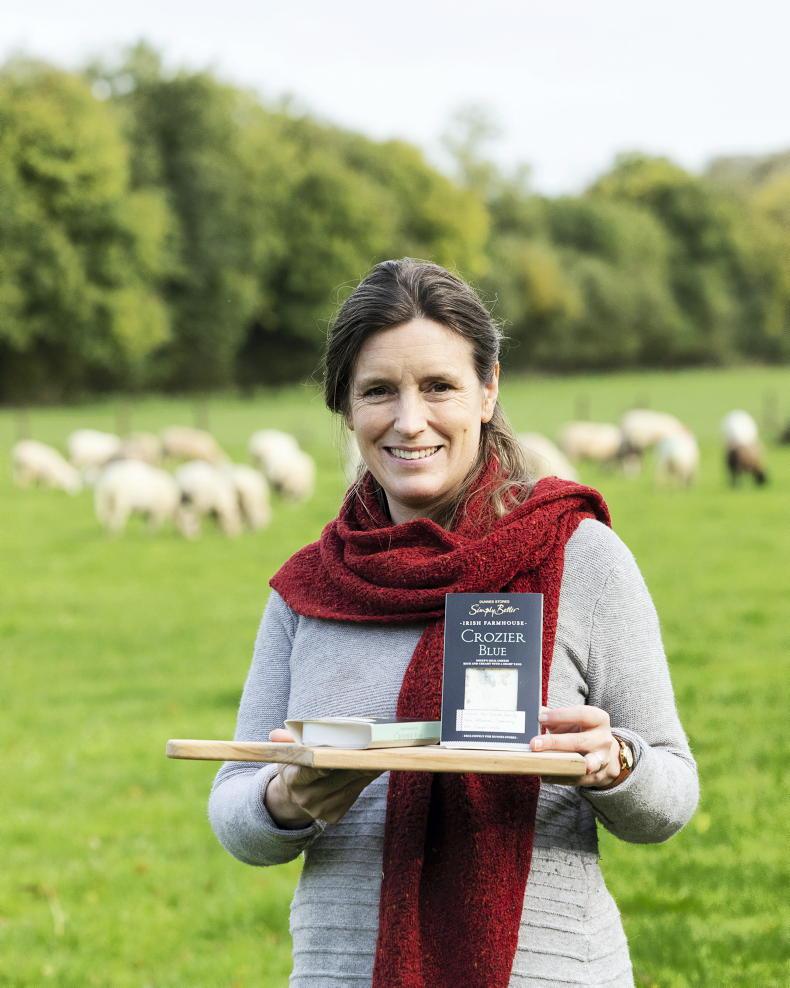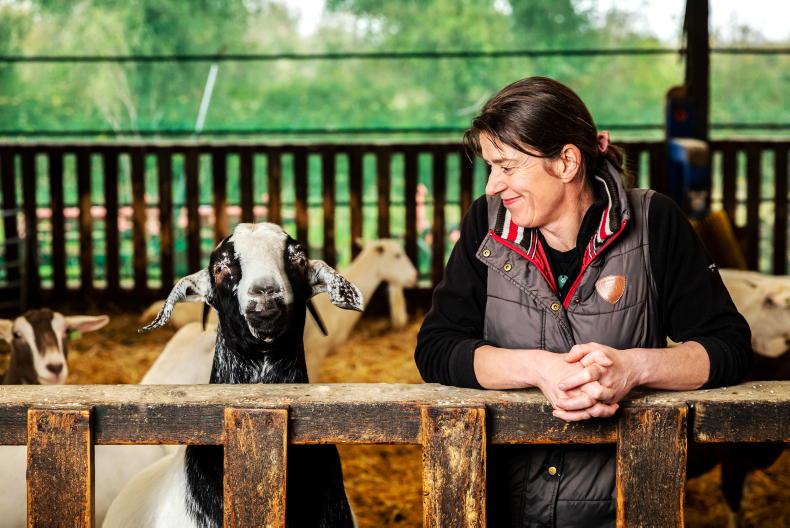Cashel Farmhouse Cheesemakers
Since the modern Irish farmhouse cheese industry was born 40 years ago, women have played a key role in driving it forward.
The Grubb family have been at the heart of it. It was Jane Grubb who started experimenting with different cheese varieties in 1980, using the milk from her husband Louis’s family farm in Beechmount Farm in Fethard, Co Tipperary.
Cashel Blue was born, and for a long time, it was the only Irish blue cheese on the market. 
In 2003, the story of Cashel Blue passed onto the next generation – to their daughter Sarah who now runs Cashel Blue with her husband Sergio Furno. On the day of our interview, the Christmas rush is so busy.
“My dad – who is now retired and in his late 70s – is hard at work today,” Sarah laughs. “As are my children, it’s definitely a family-run business.”
Sarah put her own touch on the cheese by really focusing on the maturation of their range, which includes Cashel Blue made with whole cow’s milk and crozier blue, made with Friesland sheep’s milk. Sarah explains: “Working milk into curds and whey is just one part of the process of developing fine cheese. In a more-developed cheese culture, there is a whole body of work involved in its maturation, developing its quality and taste.

“This has always been a really big interest for me, aging the cheese more slowly and gradually, using the skills that we have developed as cheesemakers to create a product that is consistent while still maintaining those unique nuances and characteristics that makes farmhouse cheese so interesting.”
A finite process
It is the crozier blue which has become part of the Dunnes Stores Simply Better family of Irish farmhouse cheese. The sheep’s milk is sourced from two local farmers – Michael Crosse who is just a few fields away from the Rock of Cashel and PJ Pollard from Callan in Co Kilkenny. When it arrives to Beechmount Farm, the delicate process begins. Sarah explains: “We start by fermenting the milk and turning it into curds and whey, this takes about four hours and then it is filled into moulds, taking the form of a wheel of cheese.
“At this point, there is a lot of moisture so for three days, we keep turning the cheese. After that, we salt it and pierce the cheese to introduce passages of air so that the seasoning of penicillium roqueforti we added into the milk at the start of the make can do it’s magic.
“Penicillium roqueforti is a fungal starter culture which gives it those beautiful blue veins which develop over two to three weeks. The cheese is then wrapped and left to rest and mature on our farm for about five months before it is hand-cut and packed for the Simply Better range.”
Although the milk is pasteurised, it is not homogenised. “This allows the unique flavours of the milk and its seasonality to be reflected in the taste.”
Sarah says the Simply Better range is helping to make farmhouse cheese more accessible to people. “To get a good selection of Irish cheese, you no longer have to make a specific trip to a cheese shop. It can now be part of your weekly food shop and means more and more people are using our cheese in recipes or as a snack. And of course, it sits beautifully on a Christmas cheeseboard.
Our partnership with Simply Better has definitely given us wider exposure and it brings our Cashel Crozier Blue to the four corners of the country. It’s putting small cheese producers on a much bigger stage.”

Killeen Farmhouse goat’s cheese

Marion keeps a herd of about 200 goats which produce the milk for Killeen Farmhouse Cheese. \ Philip Doyle
Just outside Portumna in Galway, a herd of 200 goats produce the milk that give Killeen Cheese its unique flavour. The animals are fed on a grass and clover mixture. Here another woman, Marion Roeleveld, is contributing to the flavour profile of Irish farmhouse cheese. However, unlike Sarah Furno, she has no family connection to the land.

It was Haske Knippels who encouraged Marion to come visit Ireland in 2001. “Haske always wanted to farm. He arrived here in 1990 when he was about 18 and over the years, he built up his herd of goats.”
Marion had some cheese-making knowledge before moving to Ireland. During her college years, she worked at a cheese farm in the Netherlands. In 2004, Marion first started producing her goat’s cheese here. “I started with a Gouda recipe because that’s what I knew and it worked really well with the goats milk. The recipe combined with the grass-based diet of the goats – especially the clover – results in a beautifully delicate, and mild goat’s cheese. While goat’s cheese wasn’t that popular in Ireland two decades ago, the mild flavour made it a cheese that was easy to introduce to people.”
That’s not to say that Marion hasn’t had her challenges. “There were definitely a lot of mistakes made along the way. Over the years, work has gotten easier with the goats and cheese production. The interesting thing about being a cheesemaker is that you are always learning. Because you’re working with the seasonal variation of the milk from a single herd, and are depending on a live cheese culture, you are constantly fine tuning your recipe. And that’s the beauty of farmhouse cheese, while the characteristics of the product are the same, every batch has its own qualities.”

Marion experimented with the length of maturation for her cheese and realised the sweet spot was at about five months. \ Philip Doyle
Pasteurised milk is used in Marion’s Gouda recipe in which rennet (enzymes) and culture (bacteria) are added. After half an hour of coagulation, the process of cutting, heating and stirring the curds begins and two hours later it is moulded and pressed. It then goes into a salt-and-water brine where it remains for two days before it is moved to the maturation room.
Maturation
Just like Sarah Furno in Cashel Blue, Marion stresses the importance of giving the cheese time to mature and develop flavour. In fact, this has led to her Five Month 
Matured Killeen Goat’s Cheese, that Marion produces for the Simply Better range, winning Supreme Champion at the Irish Cheese Awards in 2019 as well as a gold just last month in the 2021 awards. Marion says: “We have a young goat’s cheese which is matured for six to eight weeks and that is delicate, mild and creamy. But for the Simply Better range we wanted to create something different.”
“I experimented with maturing the cheese longer and what I found was that five months was the sweet spot. It’s a good age that imparts a lovely nutty flavour to the cheese, making it stand out against other goat’s cheese products on the market. And for me as a producer, it was a maturation period that was just about doable, that worked for my business model.”
Marion says that while the grass is the foundation for quality milk, it is the natural environment of the maturation room that lays the foundation for good flavour development. The room temperature is 14-15°C, the air is rather humid, and cheeses are left on timber boards and turned regularly. “Timber lets the cheese breathe, and prevents moisture build up under the cheese, resulting in better rinds.”
Partnering with the Dunnes Stores Simply Better team has been a positive business move for Marion. Simply Better made it worthwhile to mature a predictable amount of cheese for longer and have a different product in my range. “Not only has this helped the business to get firmly established, it meant challenging myself as a cheesemaker and the effort has really paid off.”
Cashel Farmhouse Cheesemakers
Since the modern Irish farmhouse cheese industry was born 40 years ago, women have played a key role in driving it forward.
The Grubb family have been at the heart of it. It was Jane Grubb who started experimenting with different cheese varieties in 1980, using the milk from her husband Louis’s family farm in Beechmount Farm in Fethard, Co Tipperary.
Cashel Blue was born, and for a long time, it was the only Irish blue cheese on the market. 
In 2003, the story of Cashel Blue passed onto the next generation – to their daughter Sarah who now runs Cashel Blue with her husband Sergio Furno. On the day of our interview, the Christmas rush is so busy.
“My dad – who is now retired and in his late 70s – is hard at work today,” Sarah laughs. “As are my children, it’s definitely a family-run business.”
Sarah put her own touch on the cheese by really focusing on the maturation of their range, which includes Cashel Blue made with whole cow’s milk and crozier blue, made with Friesland sheep’s milk. Sarah explains: “Working milk into curds and whey is just one part of the process of developing fine cheese. In a more-developed cheese culture, there is a whole body of work involved in its maturation, developing its quality and taste.

“This has always been a really big interest for me, aging the cheese more slowly and gradually, using the skills that we have developed as cheesemakers to create a product that is consistent while still maintaining those unique nuances and characteristics that makes farmhouse cheese so interesting.”
A finite process
It is the crozier blue which has become part of the Dunnes Stores Simply Better family of Irish farmhouse cheese. The sheep’s milk is sourced from two local farmers – Michael Crosse who is just a few fields away from the Rock of Cashel and PJ Pollard from Callan in Co Kilkenny. When it arrives to Beechmount Farm, the delicate process begins. Sarah explains: “We start by fermenting the milk and turning it into curds and whey, this takes about four hours and then it is filled into moulds, taking the form of a wheel of cheese.
“At this point, there is a lot of moisture so for three days, we keep turning the cheese. After that, we salt it and pierce the cheese to introduce passages of air so that the seasoning of penicillium roqueforti we added into the milk at the start of the make can do it’s magic.
“Penicillium roqueforti is a fungal starter culture which gives it those beautiful blue veins which develop over two to three weeks. The cheese is then wrapped and left to rest and mature on our farm for about five months before it is hand-cut and packed for the Simply Better range.”
Although the milk is pasteurised, it is not homogenised. “This allows the unique flavours of the milk and its seasonality to be reflected in the taste.”
Sarah says the Simply Better range is helping to make farmhouse cheese more accessible to people. “To get a good selection of Irish cheese, you no longer have to make a specific trip to a cheese shop. It can now be part of your weekly food shop and means more and more people are using our cheese in recipes or as a snack. And of course, it sits beautifully on a Christmas cheeseboard.
Our partnership with Simply Better has definitely given us wider exposure and it brings our Cashel Crozier Blue to the four corners of the country. It’s putting small cheese producers on a much bigger stage.”

Killeen Farmhouse goat’s cheese

Marion keeps a herd of about 200 goats which produce the milk for Killeen Farmhouse Cheese. \ Philip Doyle
Just outside Portumna in Galway, a herd of 200 goats produce the milk that give Killeen Cheese its unique flavour. The animals are fed on a grass and clover mixture. Here another woman, Marion Roeleveld, is contributing to the flavour profile of Irish farmhouse cheese. However, unlike Sarah Furno, she has no family connection to the land.

It was Haske Knippels who encouraged Marion to come visit Ireland in 2001. “Haske always wanted to farm. He arrived here in 1990 when he was about 18 and over the years, he built up his herd of goats.”
Marion had some cheese-making knowledge before moving to Ireland. During her college years, she worked at a cheese farm in the Netherlands. In 2004, Marion first started producing her goat’s cheese here. “I started with a Gouda recipe because that’s what I knew and it worked really well with the goats milk. The recipe combined with the grass-based diet of the goats – especially the clover – results in a beautifully delicate, and mild goat’s cheese. While goat’s cheese wasn’t that popular in Ireland two decades ago, the mild flavour made it a cheese that was easy to introduce to people.”
That’s not to say that Marion hasn’t had her challenges. “There were definitely a lot of mistakes made along the way. Over the years, work has gotten easier with the goats and cheese production. The interesting thing about being a cheesemaker is that you are always learning. Because you’re working with the seasonal variation of the milk from a single herd, and are depending on a live cheese culture, you are constantly fine tuning your recipe. And that’s the beauty of farmhouse cheese, while the characteristics of the product are the same, every batch has its own qualities.”

Marion experimented with the length of maturation for her cheese and realised the sweet spot was at about five months. \ Philip Doyle
Pasteurised milk is used in Marion’s Gouda recipe in which rennet (enzymes) and culture (bacteria) are added. After half an hour of coagulation, the process of cutting, heating and stirring the curds begins and two hours later it is moulded and pressed. It then goes into a salt-and-water brine where it remains for two days before it is moved to the maturation room.
Maturation
Just like Sarah Furno in Cashel Blue, Marion stresses the importance of giving the cheese time to mature and develop flavour. In fact, this has led to her Five Month 
Matured Killeen Goat’s Cheese, that Marion produces for the Simply Better range, winning Supreme Champion at the Irish Cheese Awards in 2019 as well as a gold just last month in the 2021 awards. Marion says: “We have a young goat’s cheese which is matured for six to eight weeks and that is delicate, mild and creamy. But for the Simply Better range we wanted to create something different.”
“I experimented with maturing the cheese longer and what I found was that five months was the sweet spot. It’s a good age that imparts a lovely nutty flavour to the cheese, making it stand out against other goat’s cheese products on the market. And for me as a producer, it was a maturation period that was just about doable, that worked for my business model.”
Marion says that while the grass is the foundation for quality milk, it is the natural environment of the maturation room that lays the foundation for good flavour development. The room temperature is 14-15°C, the air is rather humid, and cheeses are left on timber boards and turned regularly. “Timber lets the cheese breathe, and prevents moisture build up under the cheese, resulting in better rinds.”
Partnering with the Dunnes Stores Simply Better team has been a positive business move for Marion. Simply Better made it worthwhile to mature a predictable amount of cheese for longer and have a different product in my range. “Not only has this helped the business to get firmly established, it meant challenging myself as a cheesemaker and the effort has really paid off.”














 This is a subscriber-only article
This is a subscriber-only article











SHARING OPTIONS: